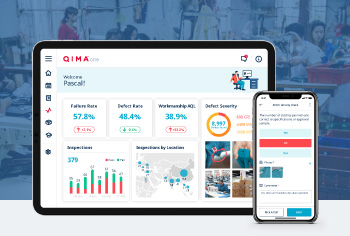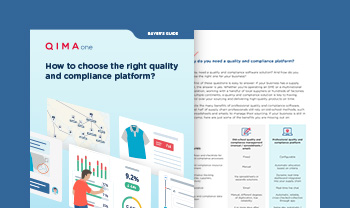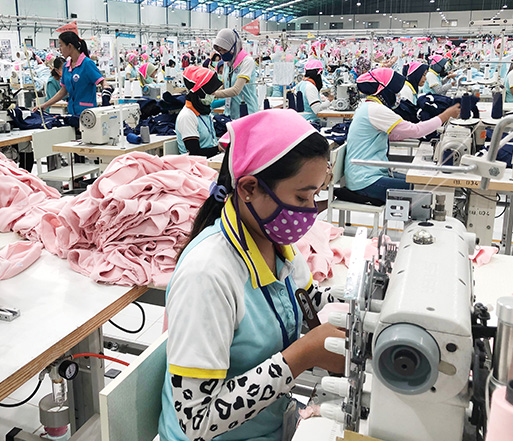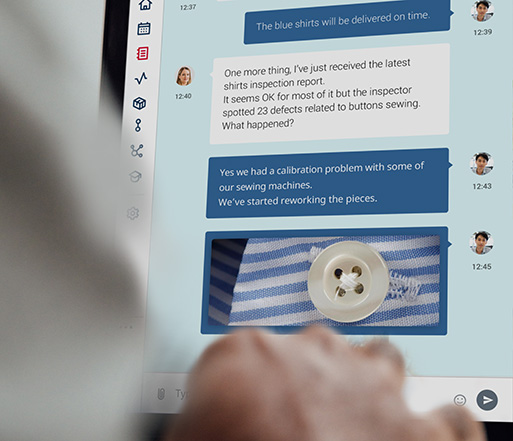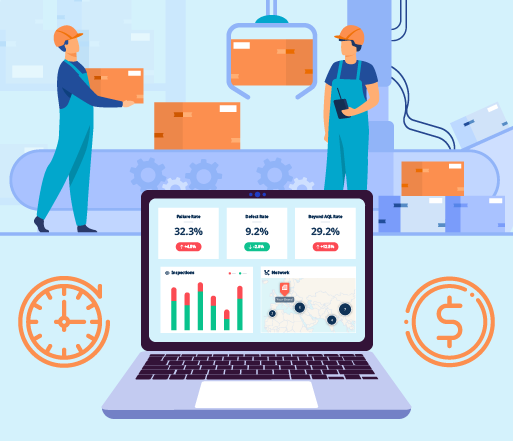
Articles
How to make the most of your supply chain data to achieve quality excellence

Articles
How to make the most of your supply chain data to achieve quality excellence
Articles
How to make the most of your supply chain data to achieve quality excellence

随时了解最新的供应链信息。
These days, modern supply chains demand full visibility along the product journey to anticipate any potential issues. To make that possible, brands, retailers and manufacturers must collect data before, during and after the production at multiple touchpoints. From the raw material factories to the retail stores through the assembly suppliers and warehouses. The more you consolidate data during multiple inspections, for instance, the more you have the chance to get actionable insights that help you prevent any supply chain risks.
However, collecting poor quality data is even more damaging than not collecting data at all. If you don’t ensure that the data collected is trustworthy, you might end up with false information that lead to wrong decisions.
Successful supply chain and quality control (QC) managers understand how to make sure that the data they collect is high enough quality to make confident, accurate decisions that improve their companies’ bottom lines.
The Impact poor data has on Supply Chain Management
There are various ways in which poor quality data can be collected during inspections and audits: inaccurate measurements, deliberately deceptive reporting, delayed or late reports and confusing or hard-to-read reports. Capturing inaccurate data can multiply business inefficiencies. Since quality control teams rely on data from reports to fuel their supply chain decisions, poor quality data results in poor decision-making. For example, metrics like inspection failure rate or major defects might not be collected at all. Measuring such metrics can help managers outline strategies.
When that data is collected by the factory workers, it’s reported on paper, making consolidation of data into actionable dashboards complicated for the QC and QA teams. Even with Excel and emails, QC managers must perform low value-added manual tasks rather than focusing on making smart decisions for the business. According to Reuters, 47% of companies still rely on Excel, and only 22% had any advanced analytics initiatives in place at the time of the survey.
Quality teams find accurate, actionable data collection is difficult because most companies have a diverse supply chain operated by people around the world, collecting data in different countries, at different times, in different languages, with different methodologies prone to human error. In fact, a recent LNS Research study showed 37% of supply chain executives say that such fragmented data and unactionable analytics are their main challenge.
The 5 Common Reasons of Poor data collection
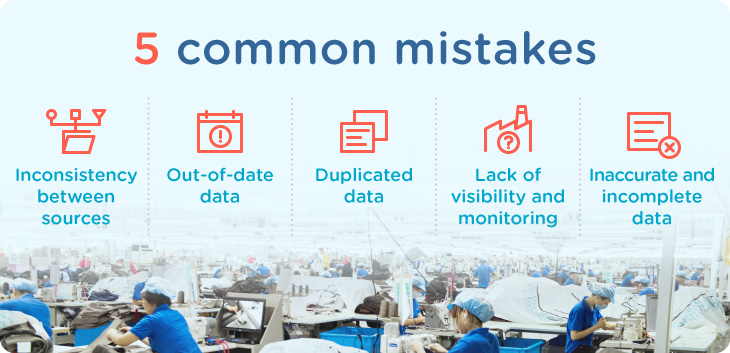
Supply chain experts have identified five common reasons businesses still collect poor data in their supply chains. It’s important to remember that the individual pieces of data often suffer from more than one of these loopholes.
1. Inconsistency between sources: When information communicated by the buyers and the suppliers differ.
When there is inconsistency between the sources, the inaccurate or misleading information can lead to poor decisions that cost the company a lot of time and money. Inconsistent data creates confusion that hurts the entire value chain and hampers internal and external decision-making processes.
2. Out-of-date data: When information/measurements are shared or recorded too late across the supply chain.
If reports are not updated regularly with new, relevant data, it makes it difficult for QC managers to make timely decisions. Reports that are not shared in a timely fashion will make it impossible for brands to compare trends and anticipate changing needs.
3. Duplicated data: When data isn’t consolidated into standardized reports that remove redundant pieces of information.
Duplicated data usually occurs when the company doesn’t have the right tool to consolidate information collected from multiple inspections on the same products. Manually consolidating data is a low value-added, high-labor activity that drains personnel resources who can be better used responding to actionable insights.
Recording multiple data inputs can blindside brands that cannot track variations. Duplicate data creates corrupt reports and inaccurate analytics, which can drastically slow down the digital transformation of any businesses who are willing to leverage advanced analytics to manage quality and compliance.
Duplicate data requires increased storage space, slowing systems and reducing efficiency while increasing costs.
4. Lack of visibility and monitoring: When data from inspections isn’t comprehensive enough to manage the entire supply chain.
According to Supply Chain Dive, 94% of businesses fail to have full visibility of their supply chain and logistic operations. The main causes include neglecting collaboration with stakeholders or the lack of collecting quality real time data to support operations.
Relying on complex and disconnected supply chain processes with poor quality data impacts the ability to effectively orchestrate changes across the entire supply chain.
According to McKinsey and Company, monitoring poor supplier performance is essential for brands to prevent delay, defective products, and reworks. Additionally, proper monitoring helps eliminate risk of operating blind.
5. Inaccurate and incomplete data: When reports contain incorrect information or missing important data points.
Honest mistakes by the inspector, like typing errors or missing data fields, can create confusion or result in delays when inaccurate data is recorded or shared. Using commonly used basic web forms can set back a business due to the lack of proper input control.
Inspectors and suppliers sometimes share incorrect information to hide poor results, such as out of range measurements, defect statistics, and borderline AQL sampling.
Fast-track your digital transformation with QIMAone.
Get a live demo
Fast-track your digital transformation with QIMAone.
Get a live demoIn uncertain times, improving data quality can add resiliency to your supply chain. Consider the recent global events like the Russian-Ukraine conflict and China’s energy rationing and zero COVID policy. Clearly, there’s never been a greater need for agile and resilient sourcing strategies.
Even before a crisis, having good data makes managing a supply chain easier and more cost-effective. Most importantly, visibility throughout your supply chain helps ensure that customers receive their products in a timely fashion at a price that’s advantageous to them, and to you.
With proper, high-quality data, brands can utilize data analytics to assess the best and worst performers across their supply chain. Brands can rely on facts rather than a “gut feeling” as data is collected across various touchpoints in production, brands can establish and monitor key metrics over time to compare supplier performance.
Since the market is always changing, the data collection practices among brands become even more important. In order to have quality data collection, it is essential to update the data regularly, use appropriate time stamps to track measurements and ensure that the most-recent data is used to compare trends and anticipate circumstance shifts.
Quality data collection allows managers to properly track Key Performance Indicators and adjust their sourcing where necessary. According to a survey by Geodis, businesses can properly monitor their supply chain if they have the right digital software in place. The most commonly monitored KPIs using digital tools are
- Daily Performance (40% of respondents),
- Cost Reduction (35%),
- Inventory Turn (28%),
- Production and Lead Time (27%),
- Return Rate (25%),
- Return On Asset (22%).
By monitoring their KPIs better, supply chain managers can model solutions before they implement them. They gain increased visibility into sources of uncertainty, volatility, and variability. Brands and suppliers can diagnose issues and create buffers where they are required.
The Benefits of Better Data for Quality Control
With better quality data, businesses can:
- Improve quality control efforts by clearly identifying your strongest and weakest suppliers.
- Record better data by tracking individual quality performance helps businesses rank their suppliers based on performance indicators.
- Adapt their quality control strategy by giving the ability to self-inspect their trusted partners and defining specific protocols and training with new or lower-performing factories.
- Provide valuable feedback to poorly performing suppliers and can encourage improvement.
- Enact stricter controls on high-risk production orders to help ensure quality.
By using data, brands can track historical quality issues and train their QC teams to add additional tests were required. For example, requiring mold checks where necessary in humid regions, or demanding the adoption of a new code of conduct with suppliers who previously experienced integrity issues.
With better quality data, businesses can use machine learning algorithms offered by digital solutions for risk prediction to identify rising issues and catch defects earlier in the production process. Addressing defects earlier in the production process helps brands save time and money; it also helps ensure that your customers are getting the quality products they expect.
Digitization of Quality and Compliance Management for Improved data collection
By allowing brands to digitize their quality and compliance management with a modern quality management software (QMS), they can onboard all their sourcing stakeholders onto a single platform with shared standards, insights, dashboards, and action plans. This greatly reduces data collection issues related to sloppy reporting and incomplete inspections.
A digital QMS standardizes inspection processes and reporting procedures to reduce data entry errors. With a QMS in place, managers measure and respond to quality control priorities more efficiently than before. They can prioritize corrective actions based on risk level and the success of suppliers over time.
A quality management system helps brands track supplier metrics to analyze historical trends and provide actionable insights. By tracking supplier metrics, businesses can identify increasing major defects and act on them, compare failure rates between suppliers, and prevent potential integrity issues. With the right QMS, managers can highlight risk concerns based on audit scores, inspection results, supplier performance, and location.
How QIMA can help: The QIMAone Solution
Eliminate the risks of poor-quality data collection. QIMA embedded their industry proven compliance and quality control expertise into the QIMAone software to build an intuitive platform that connects brands, retailers, and suppliers to improve product quality and supply chain resilience.
Global brands and retailers like Costco, Action, IKKS, Guess? Inc. and many others already use QIMAone to significantly improve product quality in their supply chains. In fact, Guess reduced their major product defects by reducing the number of erroneous reports by 30%.
Overall, QIMAone’s global customers can save up to 50% of the time they spend managing QC.
Why should you trust QIMA?
- A global presence with more than 40 offices and labs operating in 95 countries
- Over 2,500 qualified inspectors, auditors, and lab engineers specializing in softlines, hardlines and food
- Digital since day one: more than 15 years of software building experience and the first QC service provider to offer online booking, reporting, and mobile apps
- QIMAone is used by our internal inspectors and auditors
- An in-house R&D team of developers, data scientists, UX designers, TechOps, and product managers
Would you like to learn more about how you can digitize your quality operation and achieve complete supply chain success? Book your free strategic call with our experts today!
